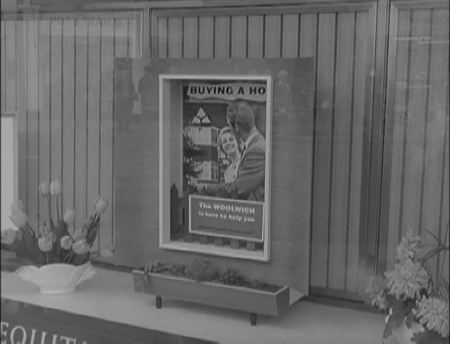 From the dread hand of Robert Hartford-Davis, who we last saw presiding over Peter Cushing’s descent into stalk’n’slash in Corruption, here comes a brutally frank drama ripped from the headlines (as it might have been called at the time). The Yellow Teddybears is based on a tabloid exposé of a girls’ school whose pupils signalled they were sexually active by wearing Robertson’s jam golliwog badges, changed to teddybears in the film. Which is just as well because if it was called The Black Golliwogs I’d be stuck for a Y. Anyway, perhaps the most impressive thing about the film is how Hartford-Davis and colleagues manage to make it both sensationalist and very, very dull.
From the dread hand of Robert Hartford-Davis, who we last saw presiding over Peter Cushing’s descent into stalk’n’slash in Corruption, here comes a brutally frank drama ripped from the headlines (as it might have been called at the time). The Yellow Teddybears is based on a tabloid exposé of a girls’ school whose pupils signalled they were sexually active by wearing Robertson’s jam golliwog badges, changed to teddybears in the film. Which is just as well because if it was called The Black Golliwogs I’d be stuck for a Y. Anyway, perhaps the most impressive thing about the film is how Hartford-Davis and colleagues manage to make it both sensationalist and very, very dull.
The main thing keeping it vaguely watchable is historical interest. Supposedly it was due to feature the Beatles’ first film appearance, but they baulked at Hartford-Davis’s insistence on writing the songs. And indeed the fairly excruciating “Yellow Teddybear” seems unlikely to have found a place in their pantheon of classic songs. Instead the role of performing goons at the ubiquitous awkward dance hall scene goes to the Embers, notable mainly for their astonishingly geeky looking keyboardist (somewhere between Buddy Holly and Bamber Gascoigne) and the alarming faces pulled by their Terry Scott-esque drummer, who seems to be enjoying himself far too much.
Also helping to make The Yellow Teddybears an intriguing historical document is its setting in that postwar would-be utopia, the new town. This one’s called Peterbridge (a cross between Peterborough and Stevenage?). Its houses are pristine boxes filled with contemporary modern knickknacks and occupied by dodgy businessmen, their empty-headed wives and their bored teenagers. Chief among the bored teenagers is Linda (Rita Tushingham lookalike Annette Whiteley), permanently sulky ringleader of the Yellow Teddybear gang. In true kitchen sink drama style she’s got pregnant by goofy would-be pop star Kinky Carson (Iain Gregory). The overplayed scene where they discuss what to do with the baby feels almost like a parody of kitchen sink clichés – but Linda already knows what she wants to do. She’s fallen in with a bad lot – chiefly June (Jill Adams), a slinky, sinister call girl who promises to procure her an abortion (it’s strange hearing people actually say words like ‘abortion’ and even ‘sex’ in a film of this vintage – something the actors seem aware of by the way they hesitantly spit the words out). It soon becomes clear that in order to pay for the procedure Linda will need to become rather better acquainted with some of June’s friends.
The mouthpiece for the film’s moral message is young biology teacher Anne Mason (Jacqueline Ellis). She’s horrified when she finds out about her students’ club, but she’s a woman of the world. She and her boyfriend (an art teacher who’s popular with the girls, even though his nose and teeth seem to be locked in a battle to decide which is scarier) have done more than hold hands. She earnestly tries to convince the schoolgirl sexpots to save themselves for someone they really love, in a charmingly period way: ‘What sort of a world are you girls living in – is it a world where sex is given out like soap coupons?’ (soap powder tends to figure heavily in 60s critiques of the affluent society and its morals). Her attempts are sadly hindered by her bizarre use of metaphor, as in this memorable exchange:
Anne: It’s degrading – it’s like taking a Picasso and using it as a fire screen.
Linda: It’s our Picasso!
Anne: So you want to hang it on the walls of a public lavatory!
Perhaps not surprisingly this all falls on deaf ears. Linda’s off for her abortion via a wistful trip through the town centre gazing sadly in shop windows at baby clothes and a rather surprising service offered by the Woolwich:
But the operation, due to be carried out by a shifty-looking doctor in June’s flat, is interrupted by Linda’s enraged dad before it can begin. Cast out of the family home, she runs off to a transport café, where despite the sage advice of a motherly tart (much more sympathetically drawn than the would-be sophisticate June), she’s last seen being picked up by a lorry driver wearing the undeniably sinister combination of a donkey jacket and a paisley cravat.
Well, that’s the reasonably entertaining part of the film over with. It grinds on for another 15 minutes or so with an interminable enquiry into poor Anne Mason’s morals by the Pharisees of the school’s board of governors, presided over by ubiquitous Britfilm authority figure Raymond Huntley. The most rabidly moralistic member’s played by Hilary Mason, star of Don’t Look Now and Maid Marian and Her Merry Men (what a CV!). It’s all rather heavy-handed, to say the least. There are just about enough incidental details about The Yellow Teddybearsto stop it being a complete borefest. But only just.

They didn't put any of Iain Gregory's songs in it, did they? There are a few on YouTube if you're feeling brave enough...
ReplyDelete